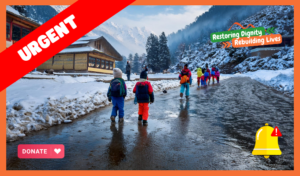
Azad Kashmir, located in the beautiful region of the Himalayas, is not only blessed with breathtaking landscapes but also faces the challenges posed by climate change and natural disasters. In this blog post, we will explore the impacts of climate change in Azad Kashmir and discuss ways to reverse its effects. Additionally, we will touch upon the risks and preparedness measures for natural disasters, particularly earthquakes.
The Impacts of Climate Change
Climate change has become a pressing global issue, and Azad Kashmir is not immune to its effects. Rising temperatures, changing rainfall patterns, and melting glaciers are just a few of the consequences faced by this region.
One of the most significant impacts of climate change in Azad Kashmir is the threat to its water resources. The melting glaciers not only affect the availability of freshwater but also increase the risk of glacial lake outburst floods (GLOFs). These floods can have devastating consequences for the local communities and infrastructure.
In addition to water-related challenges, climate change also affects agriculture, biodiversity, and overall ecosystem health. Changes in temperature and rainfall patterns disrupt traditional farming practices, leading to decreased crop yields and food insecurity. The loss of biodiversity and habitat degradation further exacerbate the vulnerability of the region.
Reversing Climate Change
While the global challenge of reversing climate change requires collective action, there are steps that can be taken at the local level in Azad Kashmir to mitigate its impacts.
1. Promoting Renewable Energy: Transitioning to renewable energy sources, such as solar and wind power, can reduce greenhouse gas emissions and decrease reliance on fossil fuels. Encouraging the use of clean energy technologies and investing in renewable energy infrastructure can pave the way for a sustainable future.
2. Conserving Forests: Forests play a crucial role in mitigating climate change by absorbing carbon dioxide and providing habitat for diverse species. Implementing effective forest management practices, promoting afforestation, and discouraging deforestation are vital steps towards preserving the natural environment.
3. Adopting Sustainable Agriculture: Encouraging farmers to adopt sustainable agricultural practices, such as organic farming and efficient irrigation systems, can help reduce the carbon footprint of the agricultural sector. Furthermore, promoting agroforestry and crop diversification can enhance resilience to changing climatic conditions.
4. Building Climate Resilient Infrastructure: Constructing resilient infrastructure that can withstand the impacts of climate change is crucial. This includes designing buildings to withstand extreme weather events, improving drainage systems to manage increased rainfall, and implementing early warning systems for floods and landslides.
Natural Disasters: Earthquakes
Azad Kashmir, located in a seismically active region, faces the constant threat of earthquakes. These natural disasters can cause significant damage to infrastructure, loss of lives, and disruptions to the local communities.
Given the high seismic activity, it is essential to prioritise earthquake preparedness in Azad Kashmir. Some key measures include:
1. Public Awareness and Education: Educating the public about earthquake safety measures, including how to respond during an earthquake and the importance of building earthquake-resistant structures, can save lives and minimise damage.
2. Building Codes and Regulations: Implementing and enforcing strict building codes and regulations that consider seismic resilience is crucial. This ensures that new constructions and renovations are designed to withstand earthquakes.
3. Strengthening Infrastructure: Retrofitting existing infrastructure, such as bridges and schools, to make them more resilient to earthquakes is essential. Additionally, conducting regular inspections and maintenance of critical infrastructure can help identify potential vulnerabilities.
4. Emergency Response Planning: Developing comprehensive emergency response plans that involve coordination between various stakeholders, including government agencies, NGOs, and local communities, is vital. This includes establishing evacuation routes, setting up emergency shelters, and conducting regular drills.
Azad Kashmir faces the dual challenges of climate change and the constant risk of earthquakes. By implementing measures to reverse climate change and mitigate the impacts, such as promoting renewable energy, conserving forests, adopting sustainable agriculture, and building climate-resilient infrastructure, we can work towards a more sustainable and resilient future for this beautiful region.
Simultaneously, prioritising earthquake preparedness through public awareness, building codes, infrastructure strengthening, and emergency response planning can help minimise the devastating effects of earthquakes. Together, we can protect Azad Kashmir and create a safer and more sustainable environment for future generations.
 Quick Donate
Quick Donate  Latest Updates
Latest Updates Contact Us
Contact Us






















